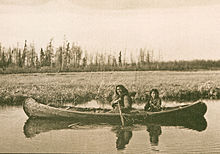 A Chipewyan woman and child set out to hunt muskrat in Garson Lake, Saskatchewan | |
| Total population | |
|---|---|
| 30,910 (2016 census)[1] | |
| Regions with significant populations | |
| Canada | |
| Saskatchewan | 12,875 |
| Northwest Territories | 7,820 |
| Alberta | 6,350 |
| Manitoba | 1,905 |
| British Columbia | 1,225 |
| Languages | |
| English, Denesuline | |
| Religion | |
| Christianity, Animism | |
| Related ethnic groups | |
| Dene, Yellowknives, Tłı̨chǫ, Slavey, Sahtu | |
| People | Dënë Sųłinë́ |
|---|---|
| Language | Dënë Sųłinë́ Yatıé |
| Country | Dënë Sųłinë́ Nëné, Denendeh ᑌᓀᐣᑌᐧ |
| Indigenous peoples in Canada |
|---|
 |
|
|
The Chipewyan (/ˌtʃɪpəˈwaɪən/ CHIP-ə-WY-ən, also called Denésoliné or Dënesųłı̨né or Dënë Sųłınë́, meaning "the original/real people")[2][3] are a Dene Indigenous Canadian people of the Athabaskan language family, whose ancestors are identified with the Taltheilei Shale archaeological tradition.[4][5][6] They are part of the Northern Athabascan group of peoples, and hail from what is now Western Canada.
- ^ Canada, Government of Canada, Statistics (25 October 2017). "Aboriginal Ancestry Responses (73), Single and Multiple Aboriginal Responses (4), Residence on or off reserve (3), Residence inside or outside Inuit Nunangat (7), Age (8A) and Sex (3) for the Population in Private Households of Canada, Provinces and Territories, 2016 Census - 25% Sample Data". www12.statcan.gc.ca. Retrieved 2017-11-22.
{{cite web}}: CS1 maint: multiple names: authors list (link) - ^ Cook, Eung-Do (2004), A Grammar of Dëne Sųłiné (Chipewyan), Winnipeg: Algonquian and Iroquoian Linguistics, ISBN 0-921064-17-9
- ^ Laurie Bauer, 2007, The Linguistics Student's Handbook, Edinburgh
- ^ "Taltheilei Culture". Retrieved 2013-03-26.
- ^ "Archeological Traditions". canoesaskatchewan. Archived from the original on 2007-12-15. Retrieved 2007-10-12.
- ^ "Denesuline (Dene)". Encyclopedia of Saskatchewan. Archived from the original on 2017-08-10. Retrieved 2008-10-27.